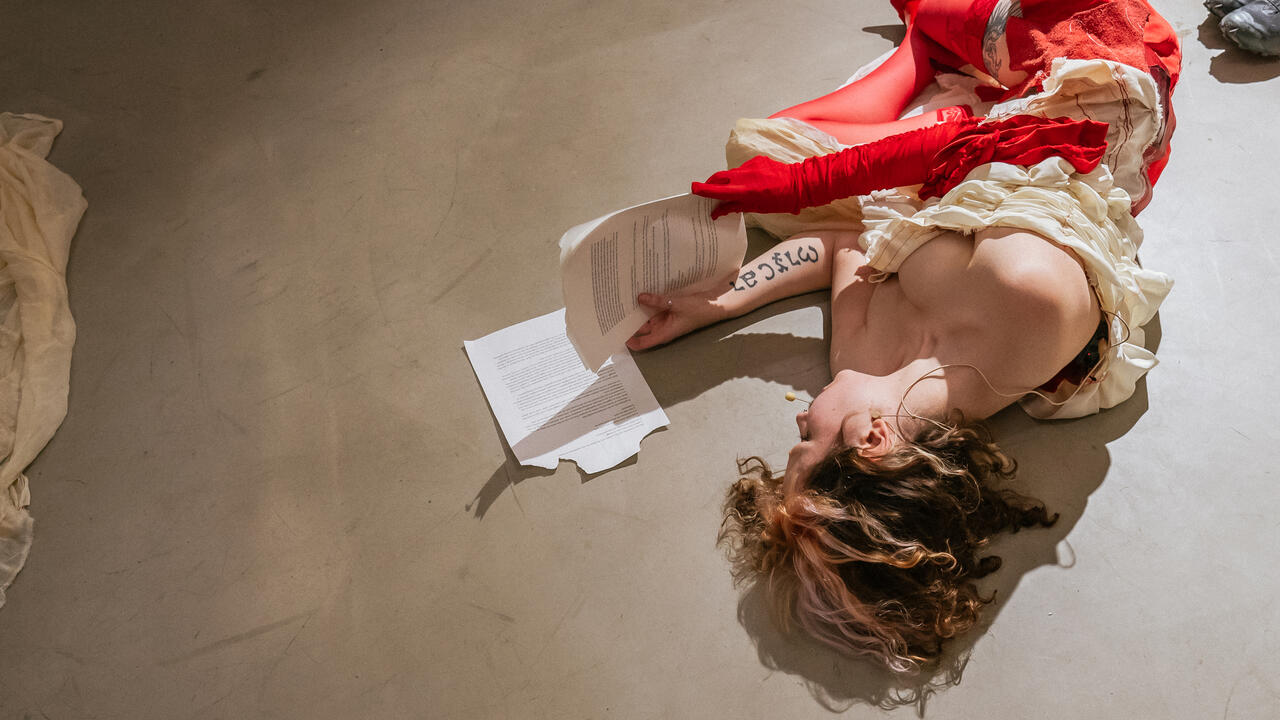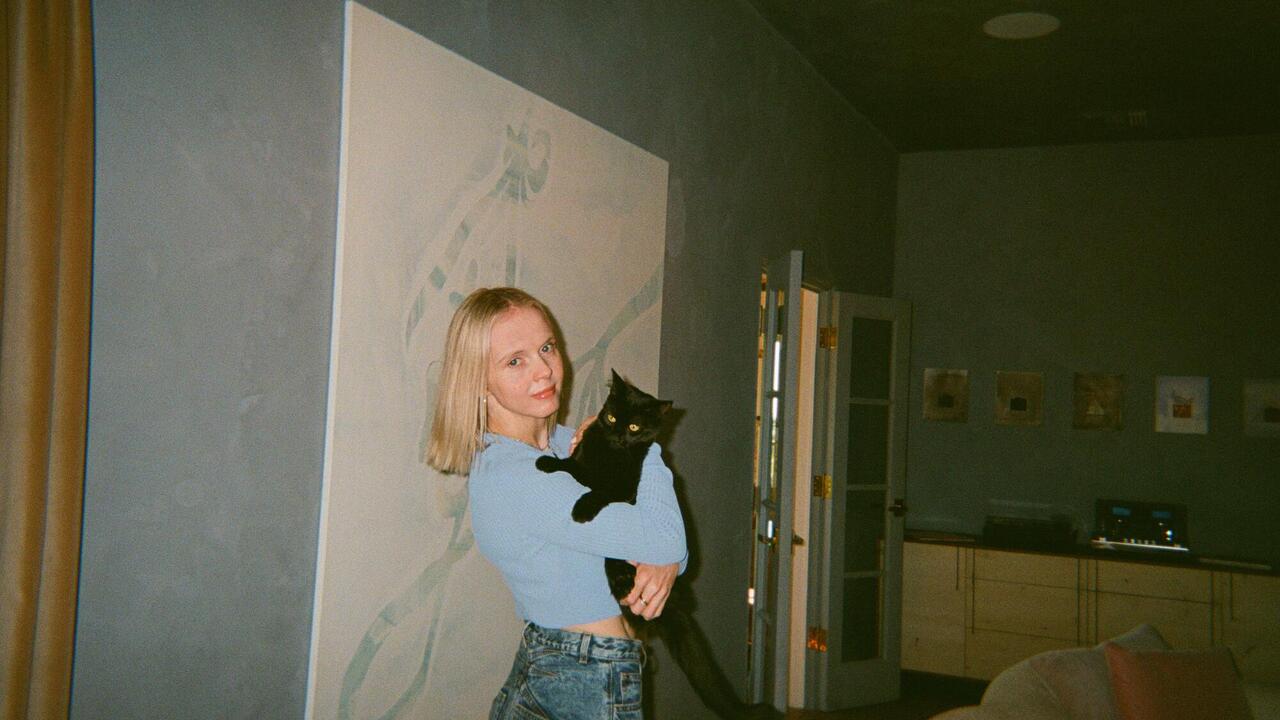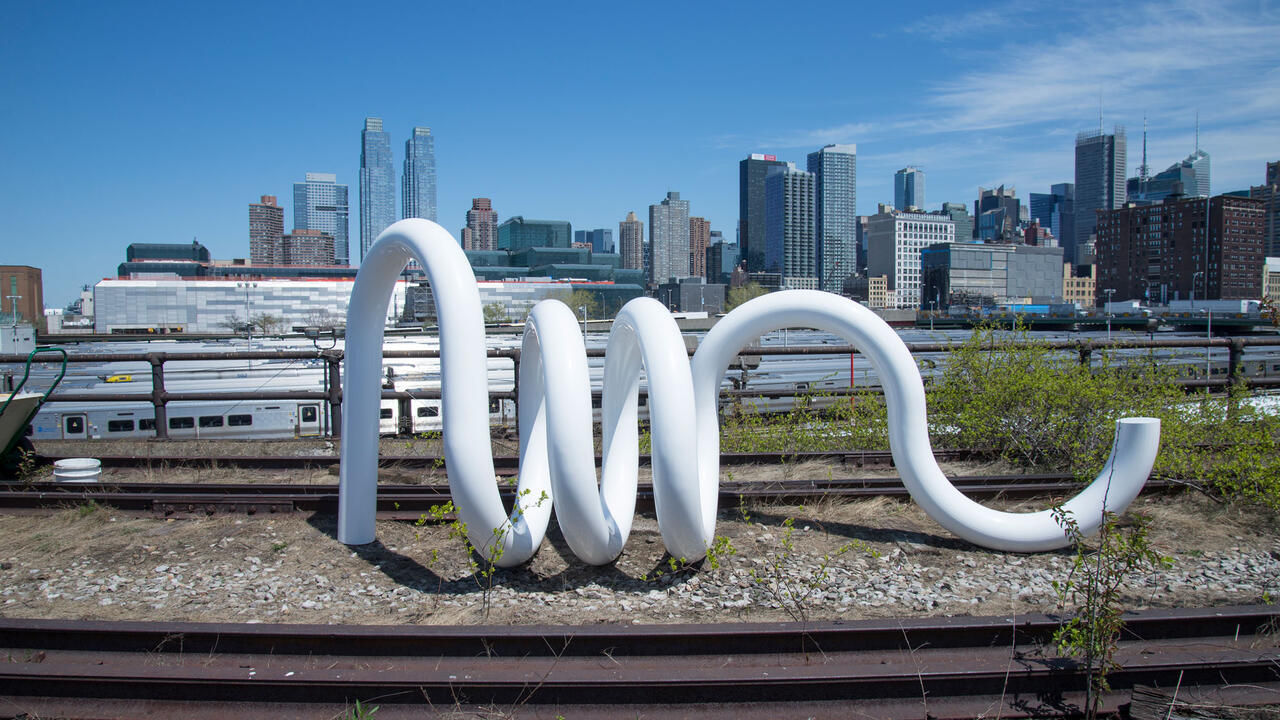Round The Horn
Rebecca Horn speaks to Stuart Morgan about the use of tension and taboo in her practice
Rebecca Horn speaks to Stuart Morgan about the use of tension and taboo in her practice

Stuart Morgan How did you feel about your retrospective at the Guggenheim Museum in New York?
Rebecca Horn From the ramps you could see almost everything: the three spirals, the different movements... You could hear the various sounds, and as you moved around, the sounds of the sculptures changed constantly. For me it was like music, an audible funnel going up into the sky. It started in the blue eye of the pool, moving up through the roof, opening up the structure of the architecture. From the two funnel sculptures suspended high above, milk dripped all the way down through the space into the pool, producing a sound like a liquid metronome. There was a spiralling energy.
SM How will it look in London?
RH At the Tate, the exhibition will start with El Rio de la Luna, (The River of the Moon), which involves liquid mercury being pumped through lead tubes. In New York it went through different spirals, like roots moving up through the ceiling. In London it will come from the back and wind up into a tower of hospital beds, then exit through the ceiling in a circular movement. At the same time liquid will be dripping down.
SM This is an idea that has possessed you from the first: energy made visible, seeing your own blood pulsing through your veins. Despite this, an opposite idea of immobility is never far away.

RH The inner part of a machine doesn't move; things move around it. The same will be true of the exhibition here, but the visitors will have a different freedom. In the early performances, in which body sculptures were used, the audience and the performer were the same person. Events occurred in isolated spaces and were very direct, concentrating on a single figure and the dialogue between that person and the person within. Through the years the perspective has been enlarged. Now, as the visitors come and go, the different sculptures seem to be holding a conversation among themselves. Strangers walking in are involved in this dialogue. This is a circular experience: a circle of energy, of objects. In London, people will follow a certain pattern and will only be able to enter certain areas and do certain things.
SM There is a sense of regulation in what you say, and that appears in the work as a main theme. How much do you think your art has to do with pain?
RH When you are in pain, you also experience extreme fear. That can free you and give you a much wider view of yourself and your body. Why does a shaman torture himself? Because pain always gets you somewhere else. For some people it's a very creative experience.
SM So what was happening to the female figure covered entirely with black feathers in Paradise Widow in 1975? What happened to those brave members of the public who ventured into the sculpture called The Chinese Fiancée a year later, unexpectedly imprisoned in pitch darkness with no idea when or if they would be released?
RH On the one hand, the fear of being locked in. On the other, imprisonment of a different kind: you heard the soft whispers of Chinese girls, calming you down. Confusion. I like that.
SM And in the performance Unicorn and the film you made of it in 1970 you invited a perfect stranger, a young woman, to walk through the countryside dressed only in a huge horn you had made and tied to her head. Wasn't that another kind of torture or test? And if so, what was its purpose?
RH By being turned into a prisoner, she freed herself inside.
SM Is that always the case in your work?
RH Nothing 'always' happens. In my life there are links to other things you want to experience and any new experience leads somewhere else. You come from somewhere and you go somewhere and, dark though things may seem on that journey, I see this as positive, even if you put yourself in danger.
SM So the purpose is to bring about change.
RH Certainly.

SM And what you are offering seems to be a process of personal transformation, as in alchemy.
RH Yes, and alchemy is a visualising process, but in the end it serves to take your consciousness to a higher plane. The Vienna piece involved the idea of alchemy found in the writings of Rosicrucian Andrea Andrei. That you have to reach another plane by any possible means. You can do it with ropes, using them to swing on or to climb up; you can use your hands, although that is very painful; or you can use ladders...
In Vienna, I constructed a tower of ladders on a baroque staircase in a private house. It became a structure in which only one ladder was standing on the floor, and the others grew upward from it to the ceiling and out through a high window. Attached to the ladder tower were nine violins, mechanically playing to themselves in a manic, melancholy sigh. It was like passing through space to another floor where some other hope existed. I called it Space for the Nameless after a small cemetery on the banks of the Danube just outside Vienna, which is populated by the unidentified bodies of those found floating lifeless down the river. Every afternoon a gypsy violinist came and played and improvised for an hour with my nine mechanical violins. Some people felt that it was like East meeting West. To me, that is Vienna.
SM So it is true to say that my passage through your work is a ritual of transformation that you have choreographed?
RH I try to experience this chain of reactions which is also a learning process. There are rituals of circling and dancing which develop a certain energy, and they can sometimes lead one toward a certain transformation.
SM Is it about the individual or about society?
RH Obviously, I experience things personally, but that's not the basis of my method of working. I spent the winter in Vienna, inhaling all the things happening there at that moment. I visited certain places and something touched me. You go and stay there and slowly realise the message you could deliver. I created this piece and left. In the coming months it will develop its own story and mood.
SM Was that what happened in Münster?
RH Yes, it's always projected on the situation and the momentary feeling of a space or an atmosphere or a situation. The citizens of Münster were rather uneasy about what I was doing. During the Second World War the building I chose for Concert in Reverse in 1987 had been a prison, where many murders took place. People were not ready to confront their past. It took them some time to accept my installation there. Slowly over the years, they decided that the work and the tower should both remain open to the public.

SM So you break taboos.
RH At the very least, I provoke.
SM What are the great taboos?
RH Taboos change enormously within each generation, so perhaps mine are a little different from yours. Everything is possible, if you want it enough. There are different limits. You must walk close to the edge. Genet, Buñuel, Pasolini... These are people who went to the edge. That's important, even if you are attacked for it.
SM These were worldly people. How can their approaches be reconciled with the spirituality or shamanism you admire: a means of achieving higher states of being?
RH Of course, it is hard to combine spirituality and worldliness: on the one hand a monk, on the other the fact that by becoming a monk you experience extremes of desire. There are times when you experience the one and times when you need the other.
SM Rituals occur in the films - around eggs or dancing or feathers - but these seem part of a larger pattern, with processes and guides, like the phantom presence of Buster Keaton in Buster's Bedroom.
RH In that film the whole consciousness of the girl makes it seem that she is going on a voyage to know more about herself by discovering Keaton. It is a ritual voyage, a voyage of consciousness and from everyone she meets she learns something or is put into a position where she has to go through a ritual of self-understanding. The film starts in the desert and she has a blue scarf covering her eyes, so she is blindfolded. The road goes 30 miles without curves, but she nearly hits a truck, a kind of suicide to free herself from all those things that have happened in her life so far. But she succeeds and is moving toward the next threshold of danger, following the pattern of another person. In the end she has to run away to save herself, to become herself, because she has such a strong identification with another person that it has become very dangerous. She ends up in the ocean, swimming away.
SM Why Keaton?
RH What Kafka describes through his personae Karl Rossmann in Amerika or Joseph K. in The Castle is a lost, creative person who tries to understand the world and has to develop a total ritual of energy for himself in order to succeed; he constructed these absurd machines to bring himself to the point of danger by equally absurd actions. He risks his life to prove that he is stronger than the normal world.
SM And he always escapes.
RH And finds a way to succeed. It is an absurd victory, but when he gets what he wants he drops it because he doesn't know how to succeed in the normal world. He simply had to prove this for himself. It's like a game. In my view, Keaton was a great artist who couldn't take all the glamour that Hollywood built around him and became an alcoholic for ten years, after which he scarcely touched alcohol for the rest of his life.

SM And went into a rest-home like Nirvana House in Buster's Bedroom, then escaped.
RH They put him into a straitjacket but he must have been the only man in the world who could manage to escape. (Harry Houdini was his godfather and had taught him as a child.) In an interview Keaton said that he woke up to find himself on a plane going to Mexico City and opened his eyes only to find this same nurse who put him into the jacket in the first place, saying 'Happy honeymoon, darling. I'm so glad I married you.' It was like a bad dream. Over the next three years she took all his money. He became a total wreck, was unable to work and she opened a Buster Keaton beauty parlour in Hollywood. When he managed to get work again they tried to put him in awful comedies with Jimmy Durante and it was only at the end of his life that his films were rediscovered. Raymond Rohauer bought them back off the Russians - Eisenstein, for example, loved Keaton films - so they had Russian or Bulgarian subtitles. So in Buster's Bedroom the girl somehow identifies with Keaton because of her own problems. This is very dangerous, because she lacks the experience, but she wants to learn and that causes a lot of troubles. Everyone she meets in the sanatorium twirls her around by trying to teach her something.
SM So like Keaton's own life, it is a parody of a plot involving development.
RH Yes, and by the end Keaton is with her, protecting her like a shadow.
SM How does this structure relate to those of your other films, La Ferdinanda and Der Eintänzer?
RH Well, Der Eintänzer has more to do with my early performance pieces like the Berlin Exercises, made in 1975 when I came from New York and rented a small apartment in Berlin. Somehow, because it was an empty space, I did an exercise every day so that the space would become my own; I had filled it with my ideas, my body, my longing. Two years later, back in New York, Der Eintänzer was again about my own space. I was having nightmares because I had no money and I had to rent a studio. Every time I returned to New York after the summer things had been stolen or destroyed. It was a nightmare. In Europe I would dream of what would happen in my place when I wasn't there. In the end that became the idea for the film - it starts with a voice-over of me explaining that a Russian teaches ballet there and gives tango lessons every evening. It has a lot to do with my own story. And although I had a cameraman and a sound man, all the rest - make-up, decor, casting, costumes, direction - I did myself. La Ferdinanda was the first feature-length film I made for cinemas. It is set in a villa which is rented out regularly for weddings and parties and other events. The owner, an old opera singer, visits it with her friend only for a few days every year, to celebrate the fact that she is still alive.
SM Motifs from your sculpture crop up in the film too, like the swing.
RH The swing is time, like a metronome, like the dripping that went on every few seconds in Münster or from the roof of the Guggenheim. It has the same function in the film.
SM You made a sculpture with two swings for your La Ferdinanda.
RH They are the same swings.
SM It's like a dialogue between twins. And there are twins in La Ferdinanda.
RH But more importantly in Eintänzer because that contains real identical twins.
SM How did you find them?

RH I put an ad in the Village Voice and twins started arriving in my studio. It was fascinating; they are like a single unit. When one starts to talk, the other finishes a sentence. When one gets low on energy, the other takes over right away. As a unit, they are so strong. It wasn't easy, in the film, one swings out of the window and ends up dead in the street. When we shot this with the one, the other didn't turn up. In fact, she refused to come back to work until the end of the film.
SM But why have you made two films with twins?
RH It's like yin and yang in one person. They also have telepathic, nearly psychic energy running between them. Separated, they are permanently nostalgic and neither distance nor time can change this.
SM Solitude occurs a lot in your work. You've talked about a literary tradition of loneliness that stretches from Dostoevsky to Beckett.
RH To create a body of work, you need to isolate yourself, and it's difficult to deal with a normal family situation. It's painful, but it frees you to create.
SM The one thing everyone sees in your work is your use of machines.
RH Not machines. Tension. And to create moments of tension you need a vocabulary. If there is a story about people who love each other and touch and faint but who can't be together, perhaps you can tell it better with two brushes.
SM There is a difference between the way machines move and people move.
RH Yes, but there is a difference between reality and a form, a three-dimensional action in space. It stands for what emotions could be as movement. When I made Chorus of the Locusts with 36 typewriters on the ceiling typing in different rhythms, people started to dance. So you mustn't forget that part of my installations also consists of the people who go to see them. And there is a mutual effect. People are astonished at what they are doing because the machines have a life of their own. They enjoy playing their roles. And how bored they would be without visitors.
Main image: Rebecca Horn, Pencil Mask, 1972, Archive Rebecca Horn. Courtesy: © VG Bild-Kunst, Bonn 2024





















